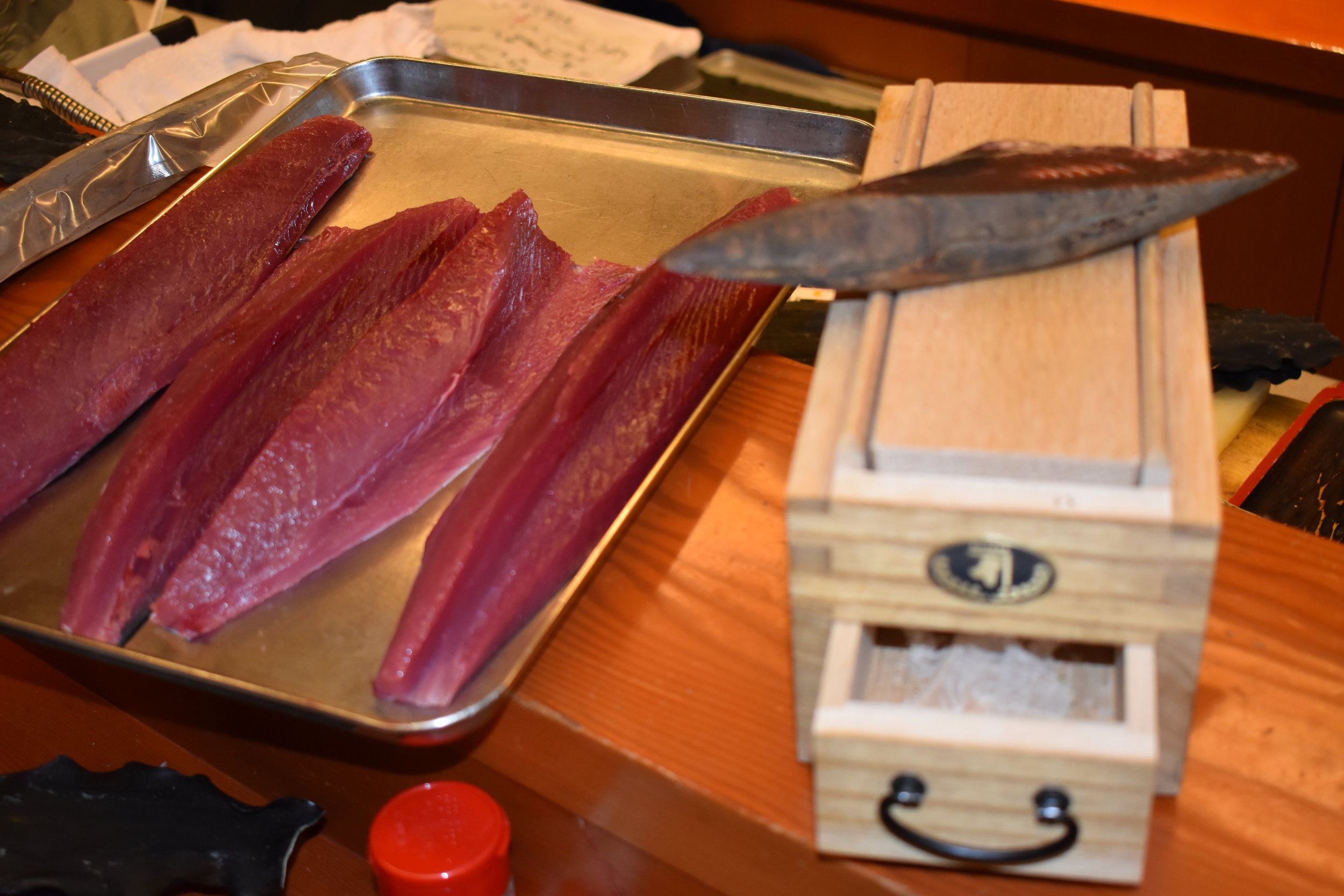MSG and Umami: Everything You Need to Know
A few weeks ago, I had the absolute pleasure of going to Japan with Ajinomoto, a Japanese food and biotech company who produces everything from seasonings to frozen food to beverages. As some of you might know, the trip was an immersion in Japanese culture, and more specifically, in Japanese cuisine. The goal: to learn more about umami and, even more so, about MSG. Full disclosure: I barely knew anything about Ajinomoto or MSG before this trip. When I was first asked to go, my initial thoughts were probably the same as yours are now: isn’t MSG bad for you?
Before agreeing to even go on the trip, I decided to do some initial research to learn more about umami and MSG. This top level research was enough alone to make me want to go on the trip. What I learned even before going to Japan, and then especially while in Japan, was this: most people (my past self included!) don’t actually even know what MSG is.
After a week in Japan learning everything possible about Japanese cuisine and MSG, I’m not exaggerating when I say I’m thrilled to share this knowledge with you. MSG might be one of the most misunderstood ingredients out there, and I’m confident that it’s not even just the dietitian in me that thinks the actual research behind it and facts about it are fascinating.
To start, what is MSG?
MSG stands for monosodium glutamate. It gives food an umami flavor. Umami, or the 5thtaste, is a savory taste. (The other 4 more commonly known tastes are: sweet, sour, salty and bitter). Umami is, technically, the taste of glutamate.
To better understand MSG, it’s easiest to break apart what monosodium glutamate actually is. MSG is simply a mixture of sodium + glutamate. Sodium is simply salt. Glutamate is an amino acid. Amino acids are the building blocks of protein. Glutamate is naturally found in foods like tomatoes, mushrooms and parmesan cheese.
The glutamate in MSG is made by fermenting sugar. Different sugar sources are used across the world depending on what what’s most available. In Asia, mainly cassava root is used, in South America, they use sugar cane and in the US, corn is used. The corn is fermented to produce glutamic acid. Then, sodium is added to create MSG.
So, MSG = the amino acid glutamate + salt. The combination of these two ingredients allows for a heightened flavor experience that provides a rich umami taste. It’s found in a crystal form (you can get it in a shaker like salt or any spice) so that it’s easiest to use.
Why add MSG?
Umami, that 5th basic taste, is the most recently discovered taste – it was discovered in Japan in 1908. It literally translates to “essence of deliciousness” in Japanese. Umami stays on the tongue longer than other flavors. It also promotes salivation. Saliva helps you enjoy food more, so it makes sense that the umami flavor is rich and widely accepted.
In Japan, the umami flavor is often added to dishes via 2 foods: kombu, or sea kelp, and dried bonito flakes, or dried skipjack tuna. These 2 foods are often used to make dashi, a common broth served in Japan. But, the umami flavor can be also be enhanced in foods by adding any food that naturally contains glutamate, like parmesan cheese.
Obviously, in the US, we’re not eating foods like kombu and bonito flakes. There are also times when adding parmesan cheese just doesn’t go with a dish (parmesan and stir fry, anyone?).
MSG is the purest form of umami – it helps to enhance the umami flavor in foods when these glutamate-containing foods, like kombu or parmesan, might not be added. Moreover, it doesn’t change the natural flavor or color of the ingredients – so if you want to enhance flavor without changing the dish entirely, MSG would be a good addition.
Most strikingly, MSG heightens flavor without adding excess salt. While salt is often added to dishes to enhance their flavor, MSG enhances flavor without as much sodium (up to a 40% reduction!). This simple combination of glutamate + sodium is actually pretty beneficial – it adds umami to food and helps to reduce overall sodium content. (In fact, the new Dietary Reference Intakes, or DRIs, actually recommend MSG as a technique to reduce sodium!)
How does it work? And does it really work?
Like I mentioned, during the week I spent in Japan, I was fortunate to learn as much as possible about umami and MSG – from making sushi and learning about umami with Dr. Kumiko Ninomiya, the director of the Umami Information Center and commonly known as the “umami mama,” to making dashi with chef Kimio Nonaga, a winner of Iron Chef Japan.
If all those names lost you, the point is this: I was able to experience umami in multiple different ways from and with people who are the top experts in the field. At each event there was always a taste test – usually broth with and without MSG. I can tell you with 100% certainty that time after time, the food with the MSG tasted significantly better. The difference was pretty crazy.
If you’re interested in the science, here’s how it works:
Receptors on the tongue recognize glutamate as the umami taste.
Glutamate alone is weak. However, when combined with something like sodium, the flavor is much stronger.
When as little as 0.05% MSG is added to a dish, it helps the flavors in that dish work together to provide a richer, fuller and overall more enhanced flavor.
Is it safe?
The safety of MSG was the part I was most interested in and, ultimately, most excited to bring home. Wondering about the safety of MSG is really valid. Especially considering how we’ve become to accustomed to simply associating it with being “bad” in the US.
Despite MSG being labeled as GRAS (Generally Recognized as Safe) by the FDA in 1958, here’s how MSG got its bad rap:
About 50 years ago, in 1968, someone wrote a letter to the editor of a medical journal saying that they got a headache from Chinese food (this letter would never have been published now!). This person said that his headache could’ve come from the MSG or from anything else in the Chinese food – including sodium, cooking alcohol, soy sauce or MSG. Yet still, somehow, his words were skewed.
Since then, negative symptoms related to MSG have continued to be perpetuated anecdotally. This means negative symptoms associated with MSG have been passed down through stories and hearsay. This single letter started both the myth of MSG being “bad” for you as well as what’s known as “Chinese Restaurant Syndrome.”
Since that letter, multiple studies were done – both on rats and humans – to verify what’s really going on with MSG:
A year later, in 1969, a study was done injecting MSG straight into rats’ abdomens. However, this study is completely invalid – it cannot be related to humans. The human body has mechanisms in place to help with absorption. Injecting anything into rats’ abdomens bypasses absorption (meaning things aren’t absorbed as they actually would be in the human body). When you inject anything in rats’ abdomens in high doses, you will see negative effects because you are bypassing absorption.
Since then, multiple human studies have been done showing no negative effects from consuming MSG the way we would in meals.
For example, in 2000, a double blind randomized trial was done with people who said they had a sensitivity to MSG. Participants were given beverages with and without MSG.
They were given a 5 gram dose – about 10x times the amount one might consume on average in a day.
As they decreased the dose less and less to amounts one might actually consume, within a few hours, only 2 of the 130 people in the study, reported any sensitivity at all.
Moreover, the reactions weren’t consistent. Those 2 people didn’t react 2 out of 3 times to the MSG challenge.
Finally, researchers foundno measurable changes reported in participants’ heart rate or any of their blood markers. The MSG did not have any significant effect on their bodies.
What about people who still feel symptoms when they eat MSG?
Symptoms can’t be discounted. I would never tell someone who says they have a headache that they don’t actually have a headache. Instead, if you’re someone who believes you’re sensitive to MSG or know someone who is, I would encourage you to think about what else might be causing these symptoms: is the salt in the food? Did you overeat? Did you drink enough water? Are you dehydrated? In fact, as far as headaches go, the International Headache Society removed MSG from its list of triggers in 2018.
Keep in mind: because of what MSG is made of, glutamate + sodium, people who believe they are sensitive to MSG would also experience the same sensitivities to foods like tomatoes, parmesan cheese and mushrooms. MSG separates into glutamate and sodium once exposed to saliva in the mouth – the body cannot distinguish between naturally present glutamate in foods and added MSG.
Finally, I know some believe they have an allergy to MSG. But, if you go back to what MSG is made of, glutamate (an amino acid) and sodium (salt), it is impossible to have an allergy to MSG. Both glutamate and salt are not allergens.
And, interestingly, the fact that MSG is associated with “Chinese Restaurant Syndrome” is cause for concern alone – as, interestingly enough, MSG originated in Japan! Like I said, the research is fascinating.
—
This is what MSG actually looks like. It’s a good addition in stir fries!
My takeaways
It’s difficult to summarize a week’s worth of experiences into one blog post. But, if you’re anything like me – someone who didn’t know much about MSG aside from hearing it’s “bad for you” – learning all of this was not only surprising, but also immensely interesting. In Japan, like I mentioned, I got to tour many parts of the Ajinomoto plant. Ajinomoto did not pay me to say positive comments, and I will say this: it is clear they put so much time, effort and care into making a product that beneficially affects food and is safe for the consumer.
Knowing what I know now, I see MSG as a huge beneficial addition to food. It enhances flavor without changing anything about the dish and without adding excess sodium. It’s made of 2 simple things: the amino acid, glutamate, and salt. Will I use it every day? Like anything else I eat, no. But, I’ve already started adding when cooking to a few dishes and I have to say, the flavor difference is incredible.
To wrap it up, I think the most telling is this story: the other week, I was making a beef and broccoli dish for my husband, Jordan, and me. While cooking, I added a little MSG to the dish. Because I don’t typically give Jordan a play by play of my cooking, I didn’t tell him that I added MSG. I served dinner and Jordan exclaimed that the broccoli was one of the best I’ve ever made.
So, naturally, I told him my secret ingredient was adding a little MSG. I had already shared with Jordan everything I’d learned about MSG, so figured he would understand the benefits of adding it. The next day however, he admitted to me that, despite the broccoli tasting amazing, he was still a little skeptical (I get it – you’re unlearning something that’s been told for decades!). He said he was expecting to feel something unpleasant that night or the next day from the MSG.
That night and the next day: he felt the same as always – no side effects whatsoever from the MSG. After all, why would he? It’s simply glutamate and sodium.
----
This blog post is only the tip of the iceberg on everything I’ve learned and want to share about MSG. If you’re interested in reading more, check out some of these recent and well written articles and blog posts:
Is MSG Safe? Umami 101: Everything You Want to Know about MSG Safety, Health and The Facts (Carlene Thomas, RD)
An MSG Convert Visits the High Church of Umami (New Yorker)
Why Americans Still Avoid MSG, Even Though Its ‘Health Effects’ Have Been Debunked (Washington Post)
This blog post is sponsored by Ajinomoto, with whom I spent a week in Japan. However, I was not paid to publish positive comments. All thoughts and opinions are my own.





